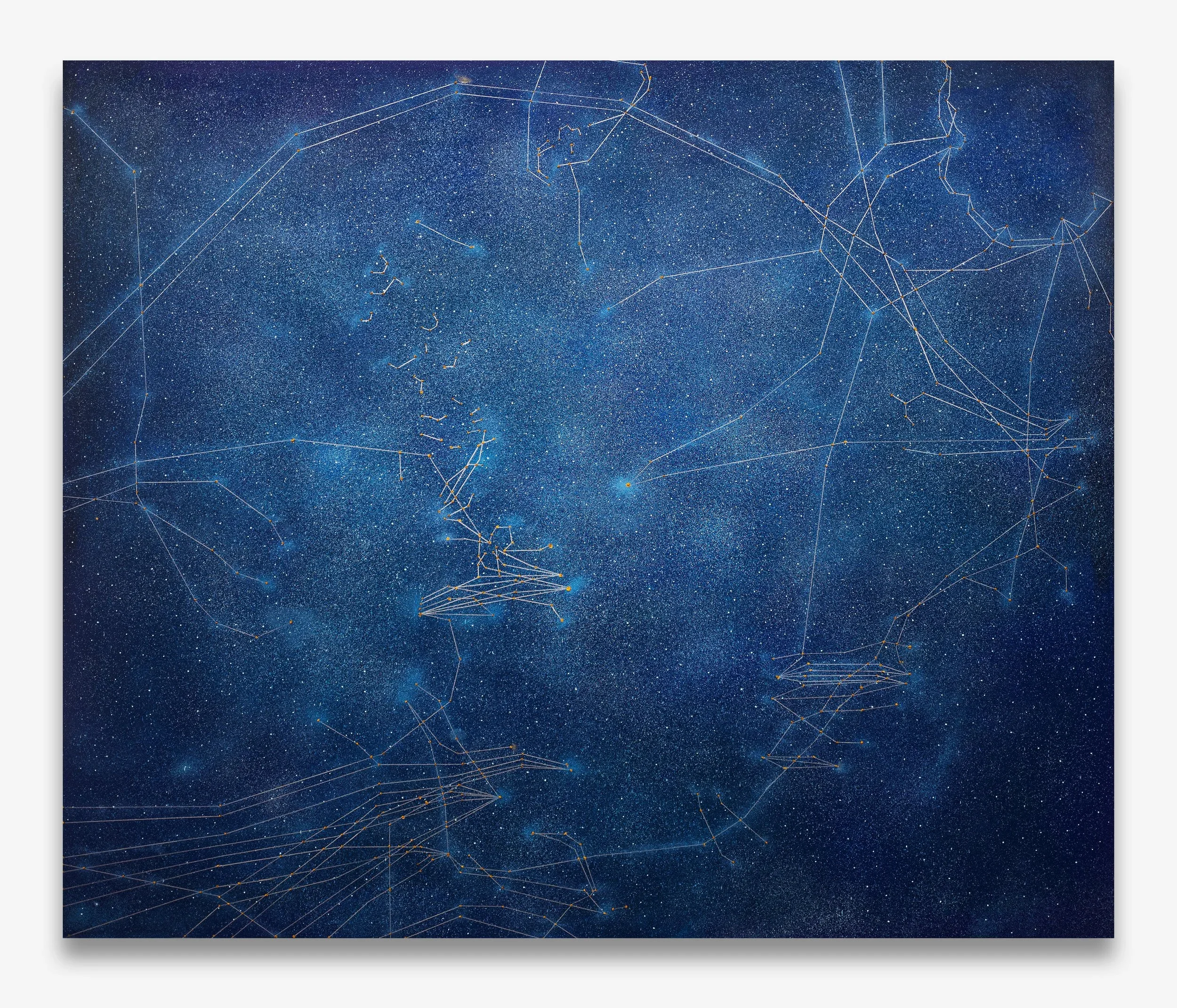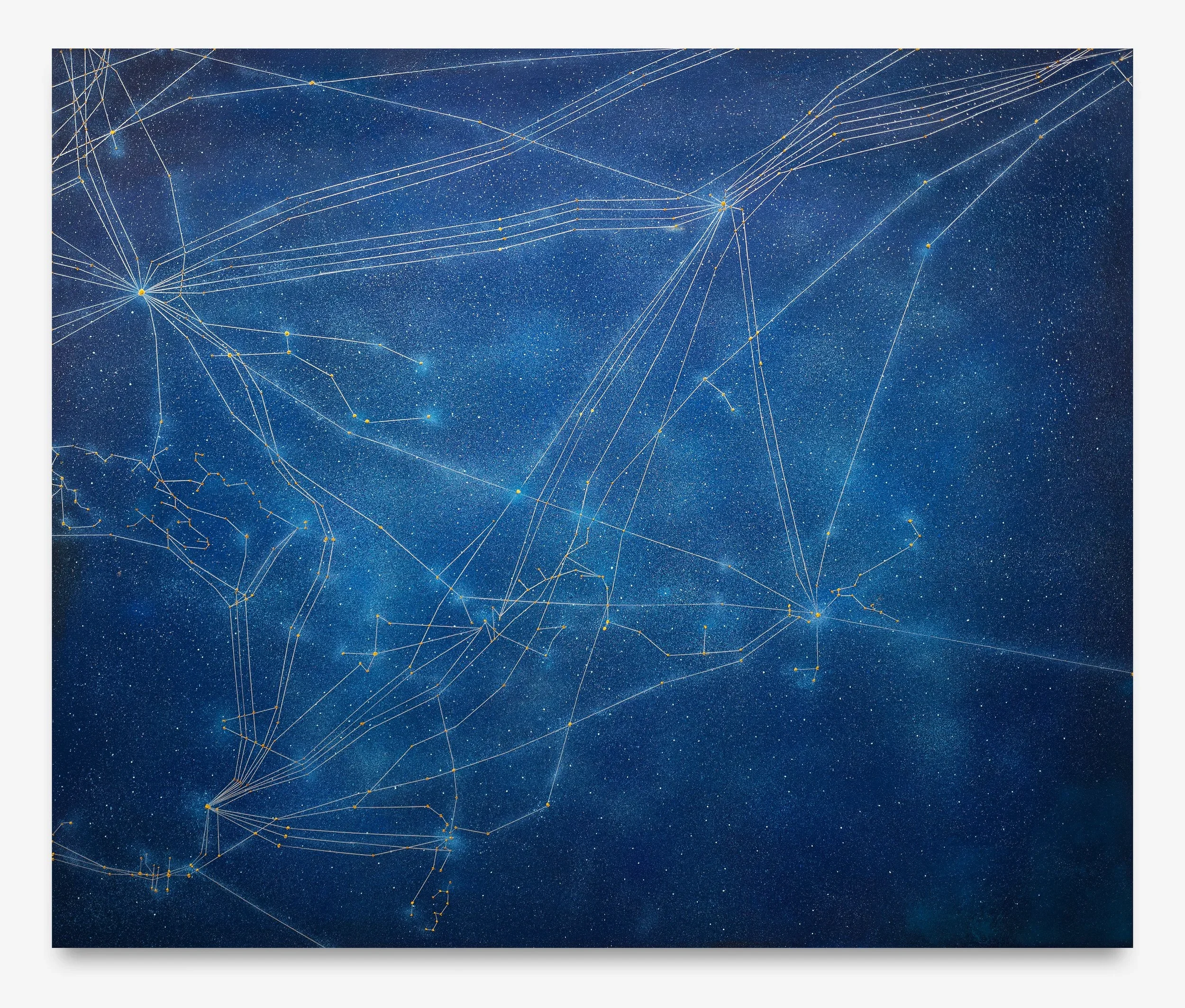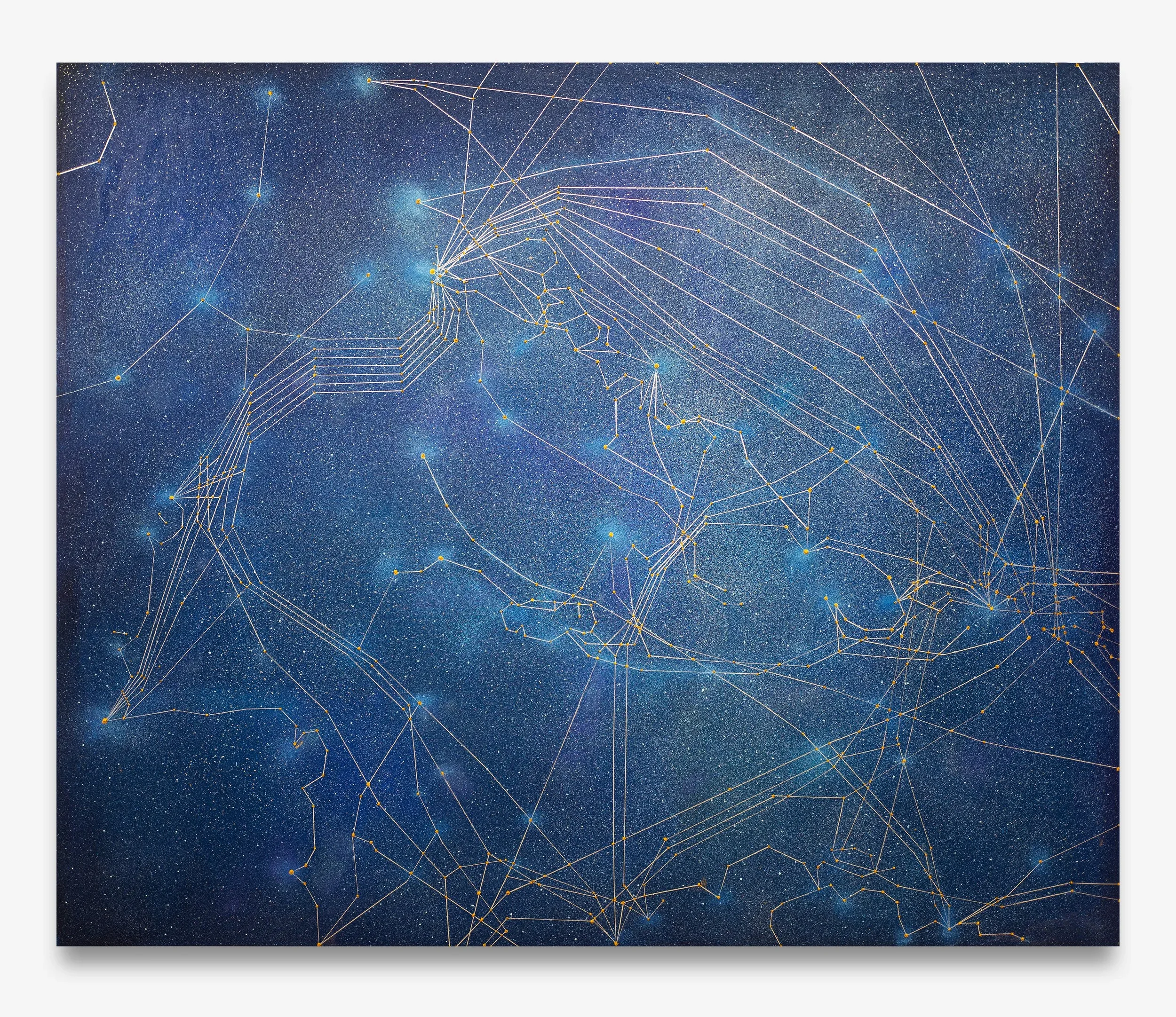Signal
Signal
Tan Mu’s ongoing Signal series is a sustained artistic investigation into the invisible architectures of global communication. Grounded in infrastructure, media geography, technological poetics, and human perception, the series transforms submarine fiber-optic networks into symbolic “digital constellations”—bridging abstraction and representation, emotion and system. Mu reimagines these hidden infrastructures not merely as technical constructs but as vessels of collective memory and human connection. By fusing planetary systems with individual and cultural histories, Signal creates poetic diagrams of connection and rupture, mapping time, scale, and collective presence.
Having entered top international collections since its debut at Art Basel Miami Beach 2024, the series will have its first comprehensive solo exhibition this Fall at BEK Forum, accompanied by music and scholarly programs.
Hosted by BEK (Büro für experimentelle Kunst), the programming around Tan Mu’s The Signal series draws on the artist’s longtime dedication to identifying, documenting, and interpreting historic moments in science and technology. The programs respond to The Signal’s visual and conceptual complexity in situating one’s being in the world on a cosmic scale and aim to build a network of artists and scholars for collaborative multimedia and cross-disciplinary works and events. Planned output involves experimental music, poetry, essays, and short films.
“Signal is both a testament to the evolution of human information networks and a prayer for future technological breakthroughs. Each brushstroke is a blessing for the next generation, envisioning freer and boundless connections.”
Studio View. Courtesy of the artist.
The ocean and Stars
Digital Constellations of Global Interconnection
This regional series of creations begins from Tan Mu's hometown, using the coordinates of personal emotion to unveil the prologue of a global narrative network.
"My relationship with the ocean began with childhood memories of the coastline." Growing up along the Shandong seaside, Tan Mu's mother was among China's first windsurfing athletes. The rhythmic tides and deep-sea tranquility she experienced while exploring nearshore waters on sailboats with her family as a child became her earliest signals for perceiving the world.
Signal: Submarine Networks 01, 2024. Oil and acrylic on linen. 150 x 180 cm (59 x 71 in) Image courtesy of Peres Projects.
Signal 01 depicts the submarine communication networks spanning the Northwest Pacific. As the first piece in the series, it holds personal significance for Tan Mu, as it includes her hometown in Shandong. Beginning with the familiar landscapes of her origins, Tan Mu traces the hidden infrastructures that connect her homeland to the wider world, marking the starting point of her exploration into the unseen currents of global data transmission.
In Signal: Submarine Network 01 (2024) depicting the Northwestern Pacific waters, the crisscrossing submarine cables form signal conduits connecting Tan Mu's home province of Shandong, China with regions like Korea and Japan, sketching a picture of information interconnectedness. Beneath layers of blue washes and star-like points, her brush revisits these vivid individual memories of exploration, pioneering, connection, and disconnection.
““I draw inspiration from ancient texts like the ‘Classic of Mountains and Seas’ and celestial maps. The ‘Classic of Mountains and Seas’ encoded our ancestors’ imaginations of unknown territories into atlases of mythical beasts, mountains, and oceans through geographical records,” Tan Mu explains. “The Signal series borrows similar poetic logic, transforming the invisible digital networks of our era into contemporary narrative maps.””
The Classic of Mountains and Seas (山海经), 4th century BCE.
Astronomical Chart Stele (天文图碑), Southern Song dynasty. Source: Suzhou Stele Museum.
When we gaze at the flickering points of light in the blue depths of the painting, it's as if we're viewing a celestial map of the digital age. These points of light are both a distant response to ancient mariners gazing at the stars and a revelation of the invisible structures upon which modern society operates—a deep-sea galaxy woven from data, signals, and algorithms. In this contemporary landscape of global interconnection, signal represents the artist's contemplation and questioning of technological nodes and epochal transitions.
Diving into the Ocean
Connection of Personal Memory and Emotion
From the very first painting in the Signal series, Tan Mu pieces together her intimate and profound connection with the ocean. Her poetic understanding of the sea, combined with childhood moments spent alongside her grandfather, converged into a fascination with hidden undersea infrastructure and the structure of world.
Her grandfather, a marine engineer involved in port design and land reclamation projects, always had his desk covered with intricate bathymetric charts and structural diagrams. Through these blueprints marked with numbers and symbols, Tan Mu understood from an early age that beneath the seemingly free waves lay an invisible order carefully constructed by humans. This unique perspective of growing up allowed her to maintain a romantic, star-like longing for the ocean while developing a systematic understanding of submarine infrastructure.
The gigantic foundations of seaside oil wells, stacked containers in ports, and the distribution of submarine network junction points—these "oceanic backbones" typically inaccessible to most people became recurring visual motifs in her artistic creation.
Signal: Submarine Networks 01 (Detail), 2024. Oil and acrylic on linen. 150 x 180 cm (59 x 71 in)
Her passion for freediving further opened a window to dialogue between her inner self and the ocean. Holding her breath while descending, with her body suspended at the point of neutral buoyancy between rising and sinking, Tan Mu describes her diving experience as entering a meditative space like an alternate realm, as if floating in a vast and peaceful universe.
This became the unique perspective presented in the Signal series.
In the Signal series, the layered texture of the oil painting medium transforms into a coexistence of multiple perspectives—deep oceanic indigo intertwining with the lines and nodes of submarine cables, as well as the shimmering glow of star clusters, creating a resonance on the canvas.
The ocean, submarine cables, and the starry sky appear simultaneously on a single visual plane. This perspective stems from Tan Mu’s physical experience during free diving: submerging into the ocean and looking upward, where the deep blue of the ocean seamlessly merges with the sky above. Through this perspective, her work captures the fusion of Earth, sky, and human, creating a stunning visual metaphor for global connectivity.
Tan Mu freediving at The Coast of Curaçao. December, 29, 2024. Courtesy of the artist.
““When I gaze at my canvas, I recall that moment of looking up at the sky while diving in the sea. Only then did I realize that the perspective in my Signal series, where the starry sky, ocean, and human labour exist on the same plane, originates from that visual experience of looking skyward from underwater.””
“Like a thread between two worlds, the freediving guide line finds its visual and conceptual echo in the submarine cable lines that thread through Tan Mu’s paintings—each line a point of return, direction, and quiet connection across immense and fluid space.”
Signal: Submarine Networks 01 (Detail), 2024. Oil and acrylic on linen. 150 x 180 cm (59 x 71 in)
A temporary memory loss caused by a diving accident unexpectedly initiated her contemplation on memory connections and disconnections. The memory blank resulting from oxygen deprivation made her brain seem to lose its signal connection with itself.
This unique experience led her to link memory systems with signal systems, giving her new insights into the structure of memory transmission and the fragility of information carriers.
““I’m interested in how these hidden infrastructures form the nervous system of our world—how they shape connection, memory, and perception. The project is unfolding gradually, like a modular archive, with each piece contributing to a larger picture of how we’re wired together.””
Signal: Submarine Networks 02 (Detail), 2025. Oil and acrylic on linen. 152 × 183 cm (60 x 72 in)
For Tan Mu, the ocean serves both as a container carrying collective memory and a codebook for interpreting memory structures—when underwater cables, like the nervous system in the brain, transmit human civilization's data packages at the speed of light, these nodes and pathways transmitting collective memory become another storage medium for Earth's memories.
Beginning from her hometown waters, Tan Mu uses her distinctive artistic perspective to interconnect submarine cable nodes with global networks, with each piece of work collectively sketching out the complex map connecting humanity. This makes the series not merely a depiction of geographical and technological landscapes but also a reflection of emotional and memorial trajectories.
Hidden Structures
Collective Memories Transmitted Through Cables
Tan Mu's focus on submarine cables began with personal childhood memories, then gradually evolved into a series of creations following an incident of signal disruption.
In January 2022, the eruption of the Hunga Tonga-Hunga Ha'apai volcano triggered intense undersea tremors, completely severing the country's external communication cables. The disconnection of signals even prevented the outside world from knowing about the volcanic eruption, causing this South Pacific island nation to "evaporate" from the global network within mere hours, becoming a literal information island in reality.
"As a freediving enthusiast, I had always dreamed of whale watching in Tonga. That sudden disconnection made me realize for the first time that what sustains our modern information world isn't satellites, but rather the deep-sea data cables hidden beneath the ocean," Tan Mu recalls.
After Tonga repaired its underwater cables and restored communications, she created Eruption (2022), depicting the Tongan volcanic eruption while documenting the impact of this geological disaster on global communication networks. This work serves both as a commemoration of rebuilt connections and a warning about disconnection. Eruption planted the conceptual seed for the Signal series, prompting her to question: What is this "signal" we depend on? How does it lose its voice in crisis, and how does it echo back in another form?
In her subsequent work Twenty Thousand Leagues Under the Sea (2023), Tan Mu shifted from specific events toward a more symbolically significant global carrier—submarine cables. Borrowing the title from Jules Verne's classic novel, the work compares modern technology to Captain Nemo's Nautilus, diving into unknown deep-sea territories. These fibers carrying floods of information are physical channels for data transmission; their cross-sectional structure metaphorically represents the convergence of cultural, economic, and social traces, and even deeper connections within collective memory.
After completing Twenty Thousand Leagues Under the Sea, Tan Mu expanded her creative focus from single geographical events to the global network system. From the cross-sectional structure of fiber optic cables to regional maps, from technological logic to human emotion, she uses painting to construct a visual field where information flows and signal disruptions coexist.
This establishment of a panoramic perspective prompted her to begin creating the Signal series—presenting the complex connected landscape of global information networks through canvas. In the Signal series, submarine cables are not merely channels for data; each cable is a "signal line" interweaving emotion and information, viewed as both recorder and transmitter of humanity's collective memories and emotions.
““I started Signal because I was fascinated by how these deep-sea infrastructures—submarine cables—connect us, yet remain completely invisible. I wanted to use painting as a way to trace, slow down, and re-embody those connections. In a way, it’s my form of visual fieldwork.
Signal is an ongoing, modular painting series that maps the global submarine cable network. Each piece focuses on a different region or node within this planetary system, using actual data maps as source material. While the works are grounded in structure and systems logic, they unfold slowly and intuitively through translucent layers—balancing the technical with the emotional.
I see the series as a visual archive of planetary infrastructure—where connection is not only technological, but also perceptual and affective. The paintings operate like soft diagrams of memory, latency, and distance.””
Signal: Submarine Networks 02, 2025. Oil and acrylic on linen. 152 × 183 cm (60 × 72 in) Image courtesy of Peres Projects.
Signal 02 depicts the submarine communication lines spanning the waters from East Asia to Southeast Asia, primarily featuring cable systems such as APCN-2, SeaMeWe-3, and SJC. The artwork highlights the role of these submarine cables in global data transmission. Through an intricate network of lines, it visualizes these hidden infrastructures, exploring how data flows in the digital age connects different regions beneath the ocean's depths.
Points and Lines
Signals, White Noise, Starry Sky, Labor
““I’m constantly shifting between technical logic and intuitive rhythm. The structure matters, but so does how the eye moves, how the hand breathes. I think that’s what painting still does better than any other medium—it lets you hold something systematic and something human, at the same time.””
In Tan Mu's studio, works from this ongoing creative series are displayed. For her, painting resembles a slow and continuous process of signal collection and redrawing—simultaneously a record and a construction.
Studio View. Courtesy of the artist.
Through the artist's labor, the temporality and emotion of signals are translated into physical traces on canvas. With precise composition, she maintains tension between abstraction and representation, arranging cable nodes like constellations, creating resonance between technological symbols and natural imagery within the same picture plane.
Studio View.Courtesy of the artist.
Layers of overlapping blue washes construct deep realms where ocean and night sky merge. Each flickering point of light is composed of pale blue, light purple, and pure white, like distant stars emitting faint light in digital streams.
Upon closer inspection, one can sense that every brushstroke is deliberate rather than random, having undergone repeated covering, adjustment, and erasure, bearing traces of time's sedimentation.
The pathways of the silent messengers of the deep are placed on this canvas where sea and starry sky blend, with nodes marked in gold or white, resembling metal contacts embedded on a motherboard. These structures attempt to respond to a world driven by data yet full of fault lines.
lSignal: Submarine Networks 02 (Detail), 2025. Oil and acrylic on linen. 152 × 183 cm (60 x 72 in)
Points and lines become the core visual language of this series. The points of light are both data packets traveling through the digital ocean veins, "white noise" in digital currents, and resonances of emotion and memory within frequency oscillations. The lines depict both the actual routes of underwater neural networks and echo the trajectories of ancient mariners who relied on celestial bodies.
Detail. Courtesy of the artist.
Using submarine cables as a nexus, Tan Mu weaves the rationality of data flows, the tension of geopolitics, the trajectory of technological evolution, and the fluctuations of individual emotions into a visualized narrative network.
Behind every brushstroke on canvas lie the calculations on engineers' drawings, traces of seabed operations, sparks from workers' welding, and the artist's emotional flows—the Signal series is a visual narrative of humanity constructing an invisible star map in the deep sea, a form of astrology about the information world.
Mapping
An Evolving Cartography of Regional Nodes
““I think of Signal as an open system—modular, ongoing, never quite finished. Each painting is a node, and together they build a kind of infrastructure archive. But instead of storing data, they store attention, gesture, time.””
Signal: Submarine Networks 03 (Detail), 2025. Oil and acrylic on linen. 152 × 183 cm (60 x 72 in)
Through the medium of underwater cables, Tan Mu deeply explores the cultural narratives, geopolitical dynamics, and technological developments of various regions.
Dynamic maps lie at the heart of the Signal Series, each artwork revealing the intricate distribution of submarine cables and the topography of specific oceanic regions. Due to differences in oceanic topography, technological thresholds, labor intensity, and construction timeframes, the global submarine network presents itself as an unbalanced “digital constellations”. They embody connections forged across vast distances while also highlighting the disconnections imposed by geographic and technological limitations, telling fragmented stories of connection and disconnection.
Studio View. Courtesy of the artist.
These submarine communication cable systems, while still essential today, may begin to phase out within the next few decades as satellite-based communication networks—such as low-earth-orbit (LEO) constellations and Laser-based Optical Communication—become more dominant.
As these buried infrastructures grow obsolete, they risk becoming forgotten relics of the information age: a quiet, decaying architecture of human connection, embedded in the ocean floor. This series serves as a visual archive of that invisible system—mapping its presence before it disappears, and offering a way to remember what once silently connected the world.
Signal: Submarine Networks 03, 2025. Oil and acrylic on linen. 152 × 183 cm (60 x 72 in) Image courtesy of Peres Projects.
Signal 03 (Dubai) depicts the submarine communication lines spanning the waters from the Persian Gulf to the Gulf of Oman, primarily featuring cable systems such as Fiber Optic Gulf (FOG), Tata TGN-Gulf, and FALCON. The artwork highlights the role of these submarine cables in global data transmission. Through an intricate network of lines, it visualizes these hidden infrastructures, exploring how data flows in the digital age connect different regions beneath the ocean's depths.
The Signal series ingeniously combines this regional expression with exhibition practices.
The first work debuted at Art Basel Miami in 2024, followed by pieces centered on Hong Kong and Dubai waters, which were subsequently exhibited at Art Basel Hong Kong and Art Dubai in 2025. While appreciating these works, viewers often find familiar geographical coordinates and cultural imprints, imbuing the works with unique geopolitical sentiments while building bridges of emotional interaction between different regions and audiences.
This September, Vienna's BEK (Büro für experimentelle Kunst) will host Tan Mu's first solo exhibition of the Signal series, where paintings from the Signal series will join works from the Gaze series and other related pieces. Through multiple media including painting, video, and live musical performance, they will collectively construct a poetic resonance spanning technology, humanity, and the cosmos.






























